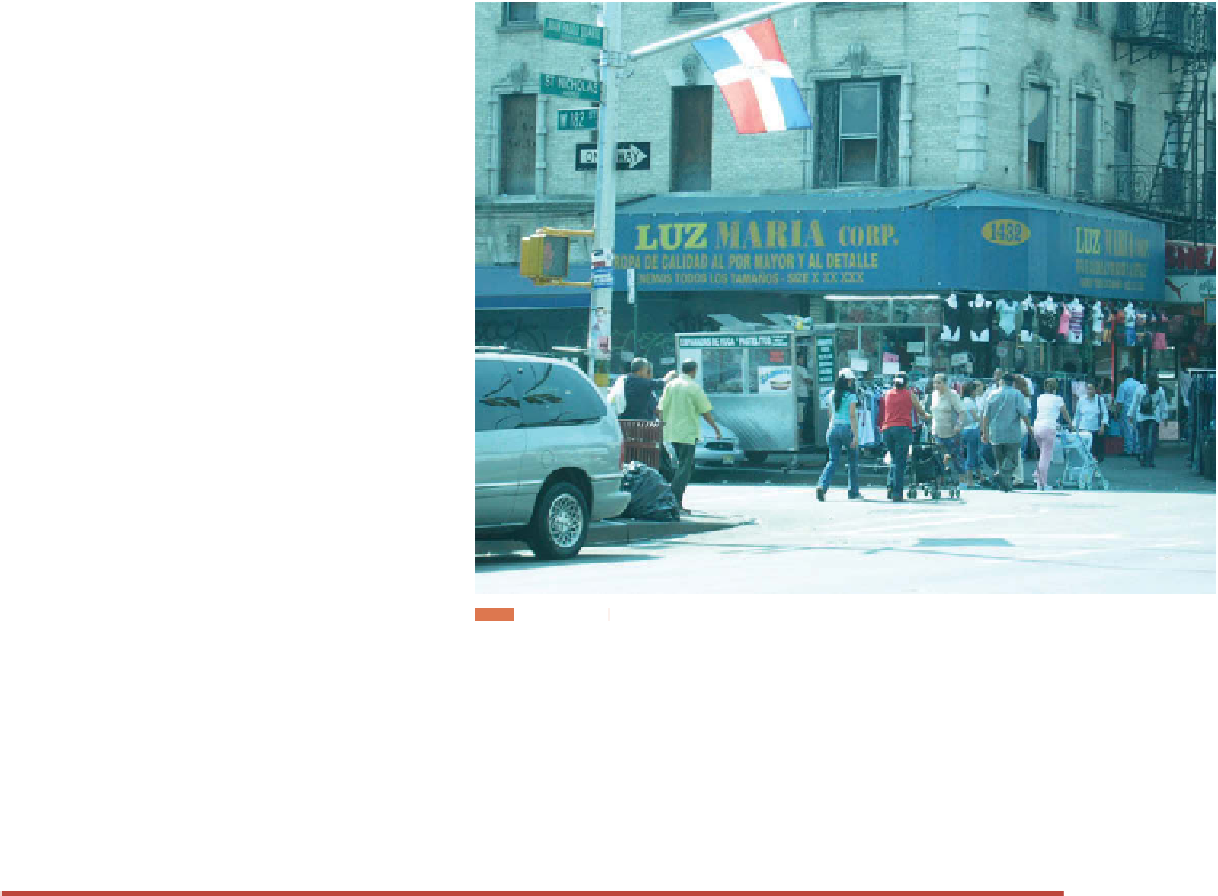Geography Reference
In-Depth Information
Guest
Field Note
Washington Heights, New York
It is a warm, humid September morning, and the
shops along Juan Pablo Duarte Boulevard are already
bustling with customers. The Dominican fl ag waves
proudly from each corner's traffi c signal. Calypso
and salsa music ring through the air, as do the
voices of Dominican grandmothers negotiating for
the best prices on fresh mangos and papayas. The
scents of fresh
empanadas de yuca
and
pastelitos
de pollo
waft from street vendor carts. The signage,
the music, the language of the street are all in Span-
ish and call out to this Dominican community. I am
not in Santo Domingo but in Washington Heights in
upper Manhattan in New York City.
Whenever I exit the “A” train at 181st Street and
walk toward St. Nicholas Avenue, renamed here Juan
Pablo Duarte Boulevard for the founding father of the
Dominican Republic, it is as if I have boarded a plane
to the island. Although there are Dominicans living
in most neighborhoods of New York's fi ve boroughs,
Washington Heights serves as the heart and soul of
the community. Dominicans began settling in Washington Heights in 1965, replacing previous Jewish, African American, and
Cuban residents through processes of invasion and succession. Over the past 40 years they have established a vibrant social
and economic enclave that is replenished daily by transnational connections to the residents' homeland. These transnational
links are pervasive on the landscape, and include travel agencies advertising daily fl ights to Santo Domingo and Puerto Plata
and stores handling
cargas, envios
, and
remesas
(material and fi nancial remittances) found on every block, as well as
farmacias
(pharmacies) selling traditional medicines and
botanicas
selling candles, statues, and other elements needed by practitioners
of Santería, a syncretistic blending of Catholicism and Yoruba beliefs practiced among many in the Spanish Caribbean.
Credit: Ines Miyares, Hunter College of the City University of New York.
Figure 5.7
norms. Miyares cautions, however, that not all Hispanics
in the city are categorically assimilated into the Caribbean
culture. Rather, the local identities of the Hispanic popu-
lations in New York vary by “borough, by neighborhood,
by era, and by source country and entry experience.” Since
1990, the greatest growth in the Hispanic population of
New York has been Mexican. Mexican migrants have set-
tled in a variety of ethnic neighborhoods, living alongside
new Chinese immigrants in Brooklyn and Puerto Ricans
in East Harlem. The process of succession continues in
New York, with Mexican immigrants moving into and
succeeding other Hispanic neighborhoods, sometimes
producing tensions between and among the local cultures.
In New York and in specifi c neighborhoods such as
East Harlem, the word
Hispanic
does little to explain the
diversity of the city. At these scales, different identities are
claimed and assigned, identities that refl ect local cultures
and neighborhoods. The overarching category “His-
panic” tells us even less about diversity when one moves
up to the scale of the United States, but as long as that
category persists in the Census, people will be encouraged
to think about it as a meaningful basis for understanding
social differences.
Recall the last time you were asked to check a box for
your race. Does that box factor into how you make sense
of yourself individually, locally, regionally, nationally, and
globally? What impact might it have on how other people
view you?
154












































